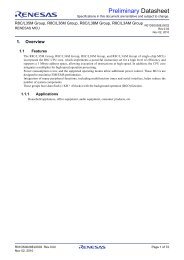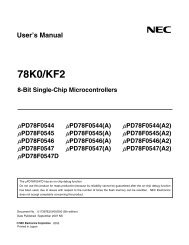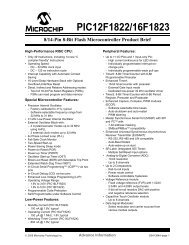xmega a3u - Elfa
xmega a3u - Elfa
xmega a3u - Elfa
Create successful ePaper yourself
Turn your PDF publications into a flip-book with our unique Google optimized e-Paper software.
XMEGA A3U<br />
7. Memories<br />
7.1 Features<br />
7.2 Overview<br />
• Flash program memory<br />
– One linear address space<br />
– In-system programmable<br />
– Self-programming and boot loader support<br />
– Application section for application code<br />
– Application table section for application code or data storage<br />
– Boot section for application code or boot loader code<br />
– Separate read/write protection lock bits for all sections<br />
– Built in fast CRC check of a selectable flash program memory section<br />
• Data memory<br />
– One linear address space<br />
– Single-cycle access from CPU<br />
– SRAM<br />
– EEPROM<br />
Byte and page accessible<br />
Optional memory mapping for direct load and store<br />
– I/O memory<br />
Configuration and status registers for all peripherals and modules<br />
16 bit-accessible general purpose registers for global variables or flags<br />
– Bus arbitration<br />
Deterministic priority handling between CPU, DMA controller, and other bus masters<br />
– Separate buses for SRAM, EEPROM and I/O memory<br />
Simultaneous bus access for CPU and DMA controller<br />
• Production signature row memory for factory programmed data<br />
– ID for each microcontroller device type<br />
– Serial number for each device<br />
– Calibration bytes for factory calibrated peripherals<br />
• User signature row<br />
– One flash page in size<br />
– Can be read and written from software<br />
– Content is kept after chip erase<br />
The Atmel AVR architecture has two main memory spaces, the program memory and the data<br />
memory. Executable code can reside only in the program memory, while data can be stored in<br />
the program memory and the data memory. The data memory includes the internal SRAM, and<br />
EEPROM for nonvolatile data storage. All memory spaces are linear and require no memory<br />
bank switching. Nonvolatile memory (NVM) spaces can be locked for further write and read/write<br />
operations. This prevents unrestricted access to the application software.<br />
A separate memory section contains the fuse bytes. These are used for configuring important<br />
system functions, and can only be written by an external programmer.<br />
The available memory size configurations are shown in ”Ordering Information” on page 2. In<br />
addition, each device has a Flash memory signature row for calibration data, device identification,<br />
serial number etc.<br />
8386B–AVR–12/11<br />
11

















